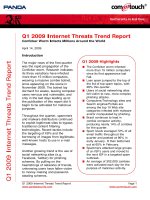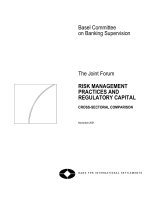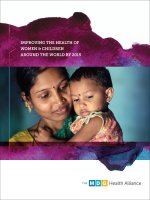Youth Savings around the World - Youth Characteristics, Savings Performance, and Potential Effects docx
Bạn đang xem bản rút gọn của tài liệu. Xem và tải ngay bản đầy đủ của tài liệu tại đây (812.41 KB, 15 trang )
Campus Box 1196 One Brookings Drive St. Louis, MO 63130-9906 (314) 935.7433 csd.wustl.edu
Youth Savings around the World
Youth Characteristics, Savings Performance, and
Potential Effects
Rainier Masa
Center for Social Development
Margaret Sherrard Sherraden
University of Missouri – St. Louis
Center for Social Development
Li Zou
Center for Social Development
Fred Ssewamala
Columbia University
Lissa Johnson
Center for Social Development
David Ansong
Center for Social Development
Gina Chowa
University of North Carolina
Michael Sherraden
Center for Social Development
2010
CSD Research Report
No. 19-15
Y OUTH S AVINGS AROUND THE W ORLD
C ENTER FOR S OCIAL D EVELOPMENT
W ASHINGTON U NIVERSITY IN S T . L OUIS
1
Youth Savings around the World:
Youth Characteristics, Savings Performance, and
Potential Effects
The global population of youth is increasing rapidly, particularly in developing countries. A formal bank savings
account may be one of the most secure ways for these youth to protect their savings and asset accumulations. Youth
savings, however, has received relatively little scholarly attention even though financial institutions, non-profits, and
governments have initiated youth savings products in many countries. This report reviews available evidence on youth
savings programs, characteristics of youth savers, savings performance, and potential impacts of saving on youth
development.
Key words:
youth savings, assets, asset effects, developing countries, financial institutions
Introduction
The global population of youth, ages 15 to 24, will rise from just under 500 million in 1950 to 1.2
billion by 2050. Almost 90% will live in developing economies, and over 80% will live in either
Africa or Asia (Population Reference Bureau, 2009). As these young people assume adult economic
roles and responsibilities, they will increase interactions with informal and formal financial
institutions. A formal bank savings account may be one of the most secure ways for youth to protect
their savings and asset accumulations for near and future purposes. While financial institutions, non-
profits, and governments have initiated youth savings products in many countries, youth savings has
received relatively little scholarly attention. This research report reviews available evidence on youth
savings programs, characteristics of youth savers, savings performance, and potential impacts of
saving on youth development.
What We Know about Youth Saving Performance and Characteristics of Youth Savers
This section introduces youth savings programs that have been successful in mobilizing youth
participation and facilitating positive savings performance. Evidence from these and several other
savings programs suggests that there is demand for youth savings products and services. More
Acknowledgments: This is a background research document for the YouthSave project, a global
consortium supported by the MasterCard Foundation. In addition to the Center for Social
Development, the consortium includes Save the Children, the Consultative Group to Assist the
Poor (CGAP), and New America Foundation.
Y OUTH S AVINGS AROUND THE W ORLD
C ENTER FOR S OCIAL D EVELOPMENT
W ASHINGTON U NIVERSITY IN S T . L OUIS
2
importantly, these programs also suggest that youth, including low-income and underprivileged
youth, want to and can save.
Youth Can Save
Youth savings initiatives have been implemented by governments (e.g., in Canada, Hong Kong,
Singapore, South Korea, Thailand, and the United Kingdom), financial institutions (e.g., in
Guatemala, Malaysia, Mexico, the Philippines, and Sri Lanka), and non-profit organizations,
including universities (e.g., in India, Kenya, Uganda, and United States).
1
The sample programs
included in this section, although not an exhaustive list, suggest that there is an extant demand for
youth saving in developed and developing economies.
•
In Guatemala, the country’s credit union system introduced youth savings, and launched a
full-fledged marketing campaign for youth savers in 1996. By the end of 2001, youth savers
made up 21.7% of the 406,074 member clients in 28 credit unions. Total youth deposits
reached 6.4 million GTQ (780,000 USD) the same year (WOCCU, 2001).
•
In Gujarat, India, the Population Council and Self-Employed Women’s Association (SEWA)
launched an exploratory savings program to understand the saving behaviors of poor young
women. All participants reported saving their money earned through wages and gifts either
in a formal savings account or with their parents, husbands, or other family members
(Kalyanwala & Sebstad, 2006). Some of the young women also recognized the importance of
saving in a bank, and of saving money to buffer against emergencies, support their families,
and cover health care costs (Kalyanwala & Sebstad, 2006).
•
In Kenya, the Tap and Reposition Youth (TRY) project tested youth savings accounts for
out-of-school adolescent girls and young women residing in low-income and slum areas in
Nairobi (2001-2004). On average, participants doubled their savings in a formal account
from 1,700 to 3,300 KES (23 to 44 USD). Additionally, TRY participants had significantly
larger savings than non-participants. By endline, TRY girls had a mean savings of 95 USD,
while non-participants had a mean savings of 67 USD (Erulkar & Chong, 2005).
•
In Malaysia, Bank Simpanan Nasional (BSN), a development bank, actively promotes Young
Savers Clubs (YSC), a program that encourages savings activities among children and youth
ages 6 to 20. As of 2007, BSN had 60,000 YSC members, with total savings of 49 million
MYR (13.9 million USD) (WSBI, 2007). In addition, BSN also participates in a “School
Adoption Program” that educates school children on the importance of saving and sound
financial decision making.
•
In Mexico, Caja Popular Mexicana, the country’s largest credit union, and its partners (World
Council of Credit Unions, and California and Texas credit union leagues) implemented new
Y OUTH S AVINGS AROUND THE W ORLD
C ENTER FOR S OCIAL D EVELOPMENT
W ASHINGTON U NIVERSITY IN S T . L OUIS
3
product developments and financial education programs to attract more youth savers. As of
June 2005, CPM held more than 183,795 youth savings accounts. The number of youth
savings accounts increased from only 2,336 accounts in 2001 to nearly 200,000 accounts in
2005 (WOCCU, 2005).
•
In the Philippines, Cantilan Bank started a Student Savers Club (SCC) for students ages 6 to
13. The club aims to teach students the value of savings and to court potentially high value
future clients as “savers for life.” SCC account coordinators travelled from classroom to
classroom, inviting children to open student accounts and processing deposits into students’
existing accounts. The bank’s average SCC depositor was from a low-income family living in
Southern Philippines. In 2009, there were more than 4,000 SCC accounts with an
outstanding balance of 10 million PHP (219,000 USD) (General William Hotchkiss, personal
communication, October 21, 2009).
•
In Sri Lanka, Hatton National Bank (HNB) and National Savings Bank (NSB) have become
two of the country’s leading financial institutions for children and youth savings efforts. As
of June 2007, Sri Lanka’s HNB held more than 400,000 savings accounts, opened for
children in over 150 school banking units. These products accounted for 18% of HNB’s 2.2
million regular savings accounts, and the total volume of these accounts amounted to 4
billion LKR (35.3 million USD), or 6% of the bank’s total volume of regular savings
accounts (De Montesquiou, 2007). In addition, NSB’s youth savings program reached nearly
390,000 youth with total savings of 3.4 billion LKR (30 million USD) by the end of 2005
(WSBI, 2007). SANASA, Sri Lanka’s credit union system, has also provided youth access to
savings accounts. In 2004, youth savings made up 23% of voluntary deposits in more than
8,400 credit unions (WOCCU, 2006).
•
In South Africa, the Government and the country’s private investment sector launched the
Fundisa Fund in 2007, a savings program that rewards children and their families and friends
for saving for tertiary education. Fundisa offers low-income families the opportunity to save
for their children’s college or university education for as little as 40 ZAR (5 USD) a month.
A savings match of up to 600 ZAR (74 USD) per year can be added to the account (Fundisa,
n.d.). During the first year of the program, 2,743 parents and sponsors signed up. As of
December 2009, there were 6,929 Fundisa account owners. At the end of October 2009, the
total volume of the program stood at 9.5 million ZAR (approximately 1.3 million USD), a
313% increase over the 2.3 million ZAR (approximately 312,000 USD) at the end of
October 2008 (Fild, 2009).
2
•
In South Korea, the government started its Child Development Account (CDA) program by
targeting 41,500 children in the welfare system. Since its launch in 2007, the Didim
(“stepping stone”) Seed Savings Account has opened over 31,000 CDAs. Almost every child
Y OUTH S AVINGS AROUND THE W ORLD
C ENTER FOR S OCIAL D EVELOPMENT
W ASHINGTON U NIVERSITY IN S T . L OUIS
4
(98.1%) made at least one deposit during the first nine months of the program, while
monthly saving rates were consistently high, ranging between 81% and 93% (Kim, Kim, &
Hong, 2007). On average, each account received deposits of 36,000 KRW (USD 29) per
month (Nam & Han, 2009). In addition, the majority of participants expected that their
savings will be helpful when they grow up and reported that their savings had increased after
their accounts were open (Kim, Kim, & Hong, 2007). Plans are underway to expand
coverage to all children born into low-income families.
•
In Thailand, the Government Savings Bank (GSB) launched a school-based banking scheme
in 1998. This scheme offers savings accounts to young people. As of August 2007, GSB had
opened more than 510,000 accounts with a total amount of 213 million THB (6.25 million
USD) (WSBI, 2007).
•
In Uganda, the SEED/SUUBI project tested youth savings accounts for orphans who had
lost one or both parents to HIV-AIDS. Based on research findings, 132 participants with
savings accounts saved 3,729 USD, not including the 2:1 match. With the match,
participants saved a total of 11,187 USD (Curley, Ssewamala, & Han, in press). On average,
youths saved 6.33 USD per month, or 76 USD per year. With a match rate of 2:1,
participants accumulated 19 USD per month or 228 USD per year on average (Ssewamala &
Ismayilova, 2009).
3,4
•
In the United Kingdom, the Child Trust Fund (CTF) is a savings and investment account for
all children living in the UK born on or after September 1, 2002. The CTF aims to
encourage people to develop a saving habit, understand the benefits of saving and investing,
and engage with financial institutions. As of January 2009, the Child Trust Fund (CTF) had
opened more than 4 million accounts since program initiation in 2005. In addition, 72% of
low-income households opened accounts or had initiated contact with the CTF (Kempson,
Atkinson, & Collard, 2006). During 2007-2008, almost one-quarter (24%) of all CTF
account holders, including 14% of low-income families, made additional contributions (HM
Revenue and Customs, 2008). Furthermore, 31% of accounts opened by parents of low-
income children made regular contributions via monthly direct deposit into CTF accounts
(The Children’s Mutual Fund, personal communication, November 24, 2008).
•
In the United States, Saving for Education, Entrepreneurship, and Downpayment
(SEED)—a policy, practice, and research initiative to test the efficacy of and inform a
national Child Development Account (CDA) policy in the United States—demonstrated
that youth accountholders can save (Sherraden & Clancy, 2005). As of the end of the
program, 1,171 SEED participants, who were primarily minority children and youth in low-
income families at 12 community-based programs, accumulated almost 1.8 million USD
through a combination of SEED incentives, their own deposits, and earnings.
5
The average
Y OUTH S AVINGS AROUND THE W ORLD
C ENTER FOR S OCIAL D EVELOPMENT
W ASHINGTON U NIVERSITY IN S T . L OUIS
5
quarterly net savings contributed by the participant or caregiver was 30 USD per participant,
with a median of 7 USD. Overall, about 57% of participants had positive net contributions
to their accounts (i.e., deposits other than the initial deposit and benchmarks deposited
directly by programs). For these participants, the mean net contribution per quarter was 43
USD (median= 17 USD) (Mason, Nam, Clancy, Loke, & Kim, 2009). Moreover, average
initial deposits ranged from 0 to 1,000 USD, average total net earnings from 4 USD to 126
USD, and average total net contributions from 175 USD to 1,354 USD (Mason et al., 2009).
Each child, on average, received 1,518 USD in “seed” deposits for future investment
purposes (Mason et al., 2009).
Characteristics of Youth Savers
Evidence from a number of youth savings programs in various countries, such as Kenya, India, and
Uganda, suggests that youth—regardless of income, gender, age, religion, parental status, and marital
status, and other personal characteristics—want to and do save. This section addresses what we
know about the role of economic status and other socio-demographic characteristics on saving.
•
In India, a pilot project jointly undertaken by the Population Council and SEWA suggests
that adolescent women from low-income families in rural and urban areas in the country can
and do save (Kalyanwala & Sebstad, 2006).
6,7
Participants in this program came from low-
income families with different religious backgrounds (Hindu, Muslim, and Christian).
Participants, whose age ranged from 13 to 25, had also attended primary school and had
mothers who were engaged in wage work. Additionally, the majority of the young women
were working, albeit irregularly, at the time of the interview (Kalyanwala & Sebstad, 2006).
•
In Kenya, the TRY program
8
demonstrated that disadvantaged young women residing in
urban poor communities of Nairobi can and do save (Erulkar & Chong, 2005). TRY
participants were young women aged 16 to 24 who came from diverse religious backgrounds
(Muslim, Christian/Catholic) and had attended primary school. Additionally, half of the
participants had a child of their own, but more than half had never married, and more than
half lived with neither parent (Erulkar & Chong, 2005).
•
Also in Kenya, another youth savings program is currently underway that targets girls in the
Kibera slum in Nairobi. K-Rep Bank and Faulu-Kenya are the program’s financial institution
partners. Almost all of the girls (92%) who voluntarily chose to open a savings account are
currently in school. More than half live with both parents and one third live with only one
parent. Eighty-three percent of the girls did not own any assets—neither on their own nor
together with someone else. The three most common reasons they reported for saving were
for personal items like clothing and sanitary napkins (70%), education (52.5%), and
emergencies (24%) (Austrian, Ngurukie, & Sakwa, 2009).
Y OUTH S AVINGS AROUND THE W ORLD
C ENTER FOR S OCIAL D EVELOPMENT
W ASHINGTON U NIVERSITY IN S T . L OUIS
6
•
The SEED/SUUBI project provides evidence that poor families in rural Uganda can and do
save for their orphaned youth relatives when provided support and incentives (Ssewamala,
Alicea, Bannon, & Ismayilova, 2008; Ssewamala & Ismayilova, 2009). SEED/SUUBI
participants included 41% paternal orphans, 19% maternal orphans, and 40% double
orphans
9
(Curley, Ssewamala, & Han, in press; Ssewamala, Han & Neilands, 2009;
Ssewamala & Ismayilova, 2009). SEED/SUUBI participants were divided evenly between
male and female. The youth, who averaged 13.7 years of age, lived with a family member,
10
in a household that averaged six people, including three other children.
•
In the United States, SEED participants were predominantly children and youth of color
from working poor families. Participant gender was 52% female and 48% male (Mason et al.,
2009). About 40% of participants had a married caregiver, and about two-thirds had an
employed caregiver.
11
Almost one half were in families with gross income below the federal
poverty guidelines; and some were in families receiving federally subsidized public assistance,
including Temporary Assistance for Needy Families or Food Stamps (Mason et al., 2009).
What Do We Know about the Potential Effects of Savings on Youth Development?
A key question about youth savings is the potential impact on youth development. Anecdotes and
some emerging empirical evidence from the growing number of children and youth savings
programs around the world suggest positive effects. To assess impact, a study must have evidence
that youth savers have different outcomes from those who are not savers. Only a few programs,
particularly in developing countries, have been studied scientifically and rigorously. They find some
empirical evidence that saving may have positive economic, social, and health outcomes for youth
development. Research included in this section of the report is limited to studies conducted in
developing economies.
Economic and Financial Well-Being
This section addresses the available evidence on the potential impact of youth savings on income,
assets, and savings levels. Two studies, both from East Africa, suggest that there is a positive
relationship between ownership of youth savings accounts and higher levels of savings, income, and
assets. On the other hand, there are no studies yet, to our knowledge, on the impact of youth
savings on household net worth since it is difficult to measure.
•
In Kenya, scholars find a positive association between participation in a youth savings
program and higher income, savings, and household assets (Erulkar & Chong, 2005).
Although TRY participants and non-participants had comparable income levels at baseline,
incomes increased significantly (about 20% more) for TRY participants at endline, compared
to non-participants (Erulkar & Chong, 2005). Similarly, while household asset levels were
Y OUTH S AVINGS AROUND THE W ORLD
C ENTER FOR S OCIAL D EVELOPMENT
W ASHINGTON U NIVERSITY IN S T . L OUIS
7
similar across participants and non-participants at baseline, assets were considerably higher
among TRY participants at endline compared to non-participants (Erulkar and Chong,
2005). TRY participants were significantly more likely to have at least seven or more
household assets compared to non-participants. TRY participants were also more likely to
have savings, and significantly higher savings, than non-participants. By endline, TRY girls
had mean savings of 95 USD, while non-participants had mean savings of 67 USD (Erulkar
& Chong, 2005). TRY participants also were more likely to keep their savings in a safer
place, compared to non-participants, who were more likely to keep their savings at home
where it was at greater risk of being stolen or confiscated by parents, guardians, or husbands.
•
In Uganda, scholars find a positive association between participation in the SUUBI project
12
and higher savings level. On average, youths in the experimental group save 6.33 USD per
month, or 76 USD per year (Ssewamala & Ismayilova, 2009). After individual savings are
matched, the participants accumulate, on average, 228 USD per year. Aside from higher
savings level, SUUBI participants experienced a positive shift in attitudes toward saving
money, while non-participants experienced a negative shift in attitudes toward saving
(Ssewamala & Ismayilova, 2009)
Mental Health
This section reviews the available evidence on the impact of youth savings on mental health
indicators, including self-esteem and membership in a social group. Two studies suggest that there is
a positive relationship between youth savings and higher levels of self-esteem and participation in a
social group. Another study suggests that having control over one’s savings is associated with greater
decision-making and formation of specific savings goals. More notably, the studies demonstrate that
vulnerable youth, such as orphans and poor young women, benefit mentally from having savings.
•
In Uganda, AIDS-orphaned adolescents offered a matched savings account as part of the
SUUBI Project reported higher self-esteem than orphans who were not offered a savings
account (Ssewamala, Han, & Neilands, 2009). Further, self-esteem was positively associated
with self-rated health functioning status (Ssewamala et al., 2009), which was also associated
with participation in the SUUBI program. The orphans with a matched savings account had
more than twice the odds of rating their health as good or excellent than their counterparts
without a savings account. Moreover, healthy children were likely to have higher self-esteem
than children with poor or fair health functioning.
•
Another program in Allahabad, India, that offered youth savings accounts, vocational
training, and reproductive health services, found that girls aged 14 to 19 who were exposed
to the intervention were significantly more likely to have knowledge of safe spaces (defined
as places in the community where it is safe for unmarried adolescents girls to congregate), to
Y OUTH S AVINGS AROUND THE W ORLD
C ENTER FOR S OCIAL D EVELOPMENT
W ASHINGTON U NIVERSITY IN S T . L OUIS
8
be members of a group, to score higher on indexes of social skills and self-esteem, to be
informed about reproductive health, and to spend time on leisure activities (Mensch, Grant,
Sebastian, Hewett, & Huntington, 2004).
•
Evidence from Gujarat, India found that having control over one’s savings is also associated
with positive social behavior. Young women who were able to exercise control over their
financial resources through their own savings accounts were more likely than those who did
not have control to have specific savings goals; be encouraged to make their own decisions;
or be consulted by family members about the use of their savings (Kalyanwala & Sebstad,
2006)
Reproductive and Sexual Health Knowledge and Behavior
This section reviews the available evidence on the impact of youth savings on reproductive and
sexual health knowledge and behavior. Two prominent studies, one from Kenya and one from
Uganda, suggest that there is a positive association between youth savings and improved
reproductive and sexual health knowledge and behavior. These findings have important implications
for public health policy and programming for youth, particularly in Sub-Saharan Africa.
•
In addition to positive economic benefits, adolescent girls in the TRY program
demonstrated development of more empowered gender attitudes than non-TRY
participants. At endline, TRY girls’ attitudes changed on three issues. They believed that
wives should be able to refuse their husbands sex, that marriage is not the only option for an
unschooled girl, and that having a husband is not necessary to be happy (Erulkar & Chong,
2005). The reproductive health knowledge of TRY participants generally increased.
Additionally, there was indication that some TRY girls had greater ability to refuse sex and
insist on condom use, compared to their peers who had not participated in the program. For
instance, TRY participants were over 1.7 times more likely to be able to refuse their partner
sex and nearly three times more likely to be able to insist on condom use, compared to non-
participants (Erulkar & Chong, 2005).
•
In Uganda, adolescent participants in the SEED/SUUBI project had improved their HIV
prevention attitudes scores, whereas the non-participants experienced a decrease in their
scores. The results imply that adolescents who took part in the intervention had a more
positive opinion about using HIV prevention methods (Ssewamala, Alicea, Bannon, &
Ismayilova, 2008). Findings from the SUUBI Project also revealed that participants who had
a savings account experienced a beneficial impact on attitudes toward risky sexual behaviors.
Approval rates of risky sexual behaviors remained the same or decreased for girls and boys
who had a savings account, whereas approval rates of risky sexual behaviors increased
among their peers who did not have a savings account (Ssewamala, Ismayilova, McKay,
Y OUTH S AVINGS AROUND THE W ORLD
C ENTER FOR S OCIAL D EVELOPMENT
W ASHINGTON U NIVERSITY IN S T . L OUIS
9
Sperber, Bannon, & Alicea, in press). Among adolescents in the experimental group, the
impact on approval of risky sexual behaviors was greater for boys than for girls, with the
approval score for girls remaining unchanged and the rate for boys decreasing significantly
(Ssewamala et al., 2009).
Educational Attainment and Attitudes
This section reviews available evidence on the potential impact of youth savings on education. An
experimental study conducted in Uganda suggests a positive relationship between youth savings and
higher grades, test scores, and improved attitudes on education. Despite these findings, scholars, to
our knowledge, have not assessed impact of youth savings on other key education indicators (e.g.
level of educational attainment and school attendance) in a developing country context.
•
Results from the SUUBI Project reveal that orphans with a matched savings account
experienced greater expectations and confidence for future education in their educational
plans than orphans without a savings account (Curley, Ssewamala, & Han, in press). Aside
from having greater savings, orphans with a savings account reported better Primary Leaving
Examination scores
13
than their peers who were not offered a savings account. Based on the
PLE aggregates, SUUBI participants were more likely to have better school grades than their
peers who had not participated in the program. Additionally, orphans with a savings account
were found to have more future educational plans and greater confidence in their future
educational plans than their peers who had not participated (Curley et al., in press).
Conclusions and Implications for Research and Policy
As indicated by the examples in this report, youth are interested in participating in savings and are
accumulating assets in youth savings initiatives around the world. Additionally, these examples
demonstrate that saving and participation in savings programs are not limited to youth in middle-
and upper-income families. Low-income, disadvantaged, and vulnerable youth have made savings
deposits in programs that provide structures and/or incentives to encourage participation.
So far, however, the number of youth savings programs is small and therefore does not permit
strong conclusions about demand within disadvantaged youth populations. Systematic research is
required to understand what types of youth savings products and services spur positive savings
performance among various populations of youth. The better we understand youth and their savings
preferences and performance, the more effectively financial institutions and public policy can create
savings products and services that meet existing and future demand
Notably, research also suggests that youth savings has the potential to improve the well-being of
low-income and vulnerable youth, especially in economic development, mental health functioning,
reproductive and sexual health knowledge and behavior, and educational attitude and attainment.
Y OUTH S AVINGS AROUND THE W ORLD
C ENTER FOR S OCIAL D EVELOPMENT
W ASHINGTON U NIVERSITY IN S T . L OUIS
10
However, at this time, the results are only suggestive because relatively few initiatives have been
studied rigorously. Carefully designed research that includes control and comparison groups, with
quantitative and qualitative evidence, can assess impacts of savings programs and asset accumulation
on youth development.
Increasingly being “banked” (owning a savings or transaction account in a formal financial
institution) is considered the standard worldwide for basic financial capability (Chaia et al., 2009). If
appropriate products and services can be developed, and if evidence of positive effects of savings on
youth continues to build, it may be worth considering universal youth savings access. There would
be many challenges, and truly universal access would be years or decades in the future. Nonetheless,
current evidence on youth savings performance and development outcomes suggest that these
challenges should be addressed. Future research will contribute to the emerging body of evidence
and inform future initiatives that may increase youth financial inclusion and development.
Endnotes
1. Examples of youth savings programs are discussed in Masa, R. (2009). Innovations in youth saving and
asset building around the world (CSD Research Brief No. 09-52). St. Louis, MO: Washington
University, Center for Social Development.
2. The accounts are available at any Absa Bank, Nedbank, and Standard Bank branches, as well as at
South African Post Offices.
3. Average monthly deposits range from 14 US cents to 77 USD. There are no statistically significant
differences in saving by gender (6.33 USD average monthly net deposit for participating boys and
6.88 USD for participating girls) or type of orphan (7 USD for double orphans and 6.33 USD for
single orphans) (Ssewamala & Ismayilova, 2009).
4. Although these savings amounts may seem very modest, these are large sums in Uganda, where
the per capita GDP is 900 USD. The 228 USD yearly savings are almost enough to pay for two
years of a student’s education in an semi-urban public secondary school, which costs anywhere
between 150 USD and 200 USD per academic year (Ssewamala & Ismayilova, 2009).
5. Accumulation in SEED accounts came from a variety of sources, including initial deposits,
participant and caregiver contributions, benchmarks, match dollars, and investment gains.
Unmatched withdrawals, service fees, and investment losses decreased accumulation in accounts.
Data on accounts was collected from 10 of the 12 community-based programs.
6. The study was implemented in one urban and two rural locations in Gujarat. The urban sample
was drawn from poor settings in Ahmedabad district and the rural sample from Kheda and
Banaskantha districts (Kalyanwala & Sebstad, 2006).
7. The evidence in this study is qualitative, and the sample is limited to adolescent and young women
who held a savings account at SEWA.
Y OUTH S AVINGS AROUND THE W ORLD
C ENTER FOR S OCIAL D EVELOPMENT
W ASHINGTON U NIVERSITY IN S T . L OUIS
11
8. TRY is an integrated program combining savings, micro-credit, training in business and life skills,
reproductive health (RH) education, and mentoring by adults from the community to reduce the
economic vulnerability and increase the social connectedness of girls residing in low-income and
slum areas of Nairobi (Erulkar & Chong, 2005).
9. An orphan is defined as a child under the age of 18 years whose biological mother, biological
father, or both biological parents have died. In the journal articles cited, orphans are defined in
three mutually exclusive categories: 1) A paternal orphan is a child whose father has died but
whose mother is alive; 2) a maternal orphan is a child whose mother has died but whose father is
alive; and 3) a double orphan is a child whose mother and father have both died.
10. Among the primary caregivers are grandparents, aunts, and uncles. In addition, the groups differ
by the male caregiver. A higher percentage of youths in the experimental group reported having
their biological father present in the household than did youths in the control group (Curley,
Ssewamala & Han, 2009; Ssewamala, Han, & Neilands, 2009).
11. Participants’ caregivers are the mother (76%); father (10%); grandparent or other relative (5%);
or foster parent, other unrelated guardian, or self (9%) (Mason et al., 2009).
12. The SUUBI Project is one of the newly initiated economic interventions for adolescents
orphaned as a result of AIDS in Uganda. SUUBI, which means ‘‘hope’’ in a local Ugandan
language, combines the reactive care usually provided for orphaned children in Uganda with an
asset-building/economic empowerment intervention. Adolescents in the SUUBI program are
offered the opportunity to open a savings account for secondary education or for microenterprise
development (Ssewamala, Han, & Neilands, 2009; Ssewamala & Ismayilova, 2009).
13. Primary Leaving Examination (PLE) is a nationally administered standardized examination taken
by all students completing the last grade (seven) in primary schooling in Uganda (Curley et al., 2009).
Y OUTH S AVINGS AROUND THE W ORLD
C ENTER FOR S OCIAL D EVELOPMENT
W ASHINGTON U NIVERSITY IN S T . L OUIS
12
References
Austrian, K., Ngurukie, C., & Sakwa, C. (2009, October). Integrating financial education and savings
opportunities into health interventions for adolescent girls in the Kibera slum of Nairobi, Kenya. Paper
presented at the Proceedings of the 8th International Conference on Urban Health, Nairobi,
Kenya.
Chaia, A., Dalal, A., Goland, T., Gonzalez, M.J., Morduch, J., & Schiff, R. (2009). Half the world is
unbanked (Financial Access Initiative Framing Note). Retrieved November 16, 2009, from
Curley, J., Ssewamala, F. M., Han, C K. (in press). Assets and educational outcomes: Child
Development Accounts (CDAs) for orphaned children in Uganda. Children and Youth Services
Review.
De Montesquiou, A. (2007). Highlight on savings: Banking on the future. Retrieved June 12, 2008, from
Erulkar, A., & Chong, E. (2005). Evaluation of a savings and microcredit program for vulnerable young women
in Nairobi. Nairobi: Population Council.
Fild, L. (2009). South Africans serious about saving for education despite hardships. Retrieved January 10,
2010, from
/>48DE-9161-F96C9B67CCE8
Fundisa. (n.d.). Save for a child’s education with Fundisa Fund. Retrieved May 27, 2009, from
Kalyanwala, S., & Sebstad, J. (2006). Spending, saving, and borrowing: Perceptions and experiences of girls in
Gujarat. New Delhi: Population Council.
HM Revenue and Customs. (2008). Child Trust Fund detailed distributional analysis 2008. Retrieved
November 24, 2008, from />funds.htm
Kempson, E., Atkinson, A., & Collard, S. (2006). Saving for children: A baseline survey at the inception of the
Child Trust Fund (HM Revenue and Customs Research Report No. 18). London: HM Revenue
and Customs.
Kim, M., Kim, H., & Hong, M. (2007). Effective operation of Child Development Accounts in Korea
(KIHASA Policy Report 2007-85) [in Korean]. Seoul, Korea Institute for Health and Social
Affairs.
Y OUTH S AVINGS AROUND THE W ORLD
C ENTER FOR S OCIAL D EVELOPMENT
W ASHINGTON U NIVERSITY IN S T . L OUIS
13
Masa, R. (2009). Innovations in youth saving and asset building around the world (CSD Research Brief No.
09-52). St. Louis, MO: Washington University, Center for Social Development.
Mason, L. R., Nam, Y., Clancy, M., Loke, V., & Kim, Y. (2009). SEED account monitoring research:
Participants, savings, and accumulation (CSD Research Report 09-05). St. Louis, MO: Washington
University, Center for Social Development.
Mensch, B., Grant, M., Sebastian, M., Hewett, P., & Huntington, D. (2004). The effects of a livelihood
intervention in an urban slum in India: Do vocational counseling and training alter the attitudes and behavior of
adolescent girls? (Population Council Working Paper No. 194). New York: Population Council.
Nam, Y., & Han, C K. (2009). A new approach to promote economic independence among at-risk children: Child
Development Accounts (CDAs) in Korea (CSD Working Paper 09-02). St. Louis, MO: Washington
University, Center for Social Development.
Population Reference Bureau. (2009). 2009 World population data sheet. Retrieved January 20, 2010,
from
Ssewamala, F. M., Alicea, S., Bannon, W., & Ismayilova, L. (2008). A novel economic intervention
to reduce HIV risks among school-going AIDS-orphaned children in rural Uganda. Journal of
Adolescent Health, 42(1), 102-104.
Ssewamala, F. M., Han, C K., & Neilands, T. (2009). Asset ownership and health and mental health
functioning among AIDS-orphaned adolescents: Findings from a randomized clinical trial in
rural Uganda. Social Science and Medicine, 69(2), 191-198.
Ssewamala, F. M., & Ismayilova, L. (2009). Integrating children savings accounts in the care and
support of orphaned adolescents in rural Uganda. Social Service Review, 83(3), 453-472.
Ssewamala, F. M., Ismayilova, L., McKay, M., Sperber, E., Bannon, W., & Alicea, S. (in press).
Gender and the effects of an economic empowerment program on attitudes toward sexual risk-
taking among AIDS-orphaned adolescent youth in Uganda. Journal of Adolescent Health.
World Council of Credit Unions. (2001). A technical guide to savings mobilization: Lessons from credit union
experience (WOCCU Technical Guide No. 1). Madison, WI: WOCCU.
World Council of Credit Unions. (2005). Wegner award to recognize international partnerships: WOCCU,
California and Texas leagues with Mexico’s largest credit union. Retrieved July 12, 2009, from
World Council of Credit Unions. (2006). A technical guide to increasing citizen participation: How credit
unions strengthen democracy (WOCCU Technical Guide No. 6). Madison, WI: WOCCU.
Y OUTH S AVINGS AROUND THE W ORLD
C ENTER FOR S OCIAL D EVELOPMENT
W ASHINGTON U NIVERSITY IN S T . L OUIS
14
World Savings Bank Institute. (2007). Best of WSBI member trainings on savings mobilization: Ten years of
sharing innovations in the savings market. Brussels: WSBI.
World Savings Bank Institute. (2007). Examples of WSBI members’ initiatives in the field of financial
education. Brussels: WSBI.
World Savings Bank Institute. (2007). Savings bank’s socially responsible activities, a wealth of experience:
Insights from WSBI members in Africa, Asia, and the Americas. Brussels: WSBI.









